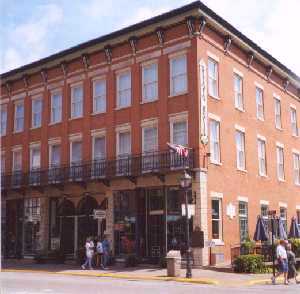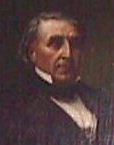Home | News | Books | Speeches | Places | Resources | Education | Timelines | Index | Search
DeSoto House
© Abraham Lincoln OnlineLincoln in Galena, Illinois
Lincoln first arrived in this hilly, picturesque northwestern Illinois town in 1832 as a soldier in the Black Hawk War. His most famous visit came 24 years later, when he campaigned for Republican presidential hopeful John Fremont. Lincoln made at least 50 speeches for Fremont in 1856, one of them from the DeSoto House balcony on Main Street -- see the black iron railing at the left.The DeSoto House
The DeSoto House, which opened in 1855, was five stories high when Lincoln stepped onto its second-floor balcony. A depressed economy and fire-fighting concerns caused removal of the top two stories in 1880. Named after the explorer Hernando DeSoto, it billed itself as "the largest and most luxurious hotel in the West." Lincoln's political rival Stephen Douglas appeared in Galena several times and spoke from the same balcony in 1858.
After the Civil War ended, grateful Galena citizens feted former resident General Ulysses S. Grant with a triumphal return on August 18, 1865. A huge arch stretched across Main Street by the hotel reading, "Hail to the Chief Who in Triumph Advances."
General Grant, of course, had long been identified with the town. Before the war he worked in a leather store on Main Street and lived in a home on High Street. By 1868, he ran for president and made the hotel his campaign headquarters. Grant's father had been one of the Galena businessmen to finance the building. Today the renovated hotel welcomes tourists with fine accommodations and dining.
Lincoln's Galena Speech
When Lincoln spoke the evening of July 23, 1856, a local paper noted that he had "a large audience, and addressed them until nearly 11 o'clock. He spoke from the balcony of the De Soto House, and a number of ladies, within the House and in rooms across the street, were among his attentive listeners."
Lincoln's speech has not been preserved in its entirety, but a newspaper summary explained that it was about "Disunion." He addressed his remarks to the opponents of Fremont and the Republican Party. He said, "If you mean that it is our aim to dissolve the Union, for myself I answer, that is untrue; for those who act with me I answer, that it is untrue." He argued that the Republican position resisting the expansion of slavery was not devisive. "All this talk about the dissolution of the Union is humbug -- nothing but folly. We WON'T dissolve the Union, and you SHAN'T," he concluded.
The paper also described Lincoln as a speaker: "His manner is neither fanciful nor rhetorical, but logical. His thoughts are strong thoughts, and are strongly joined together. He is a close reasoner, and has the faculty of making himself clearly understood. He does not leave a vague impression that he had said something worth hearing; the hearer remembers what that something is. The sledge hammer effect of his speech results from the resistless force of the logic of the logician, not the fierce gestures and loud rantings of the demagogue."
Elihu WashburneLincoln's Galena Friends One of Lincoln's most powerful political allies in town was Elihu B. Washburne, a fellow lawyer and politician. He moved from Massachusetts to the boom town of Galena in 1840 and met Lincoln that year during a Whig Party campaign. An early member of the Republican Party, he supported Lincoln's senatorial campaigns and presidency. As a multiple-term Congressman in the 1850s and 1860s, he advised Lincoln about political developments.
Edward BakerThe town also attracted Lincoln's close friend Edward Dickinson Baker, who moved from Springfield to Galena in 1848. Baker, who was a lawyer, a Whig politician and later a Republican, represented the district in Congress from 1849 to 1851. The restless Baker eventually moved to Oregon, where he gained a Senate seat. He returned to Washington, D.C. in 1861 to introduce Lincoln to the country at his first inauguration. In October 1861, Baker became the only U.S. Senator to die in a Civil War battle, falling during the disastrous campaign at Ball's Bluff, Virginia. Related Reading
Davenport, Don. In Lincoln's Footsteps: A Historical Guide to the Lincoln Sites in Illinois, Indiana, and Kentucky. Revised edition, Trails Books, 2002.Related Link
History of the DeSoto House
Home | News | Education | Timelines | Places | Resources | Books | Speeches | Index | Search Text and photos copyright © 2019 Abraham Lincoln Online. All rights reserved. Privacy Policy



